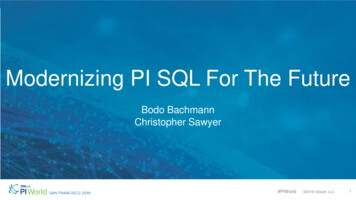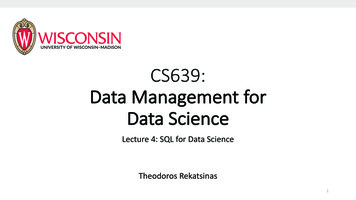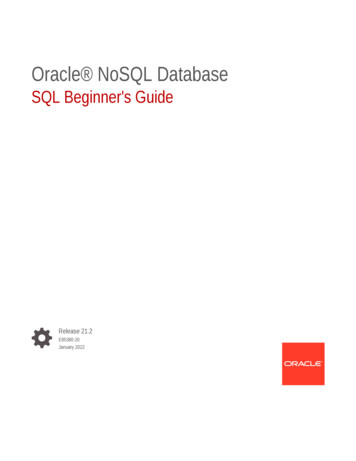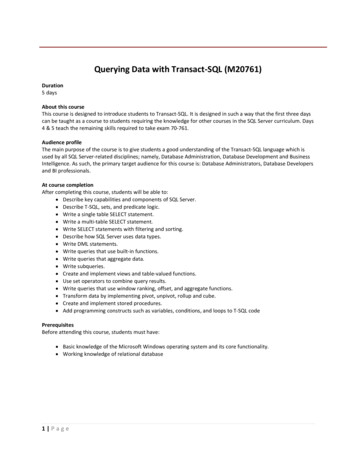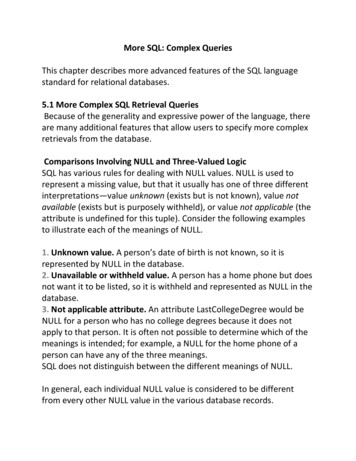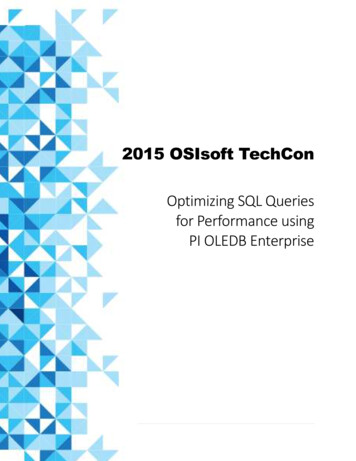
Transcription
2015 OSIsoft TechConOptimizing SQL Queriesfor Performance usingPI OLEDB Enterprise1 P age
Table of ContentsContentsTable of Contents . 1Optimizing SQL Queries for Performance using PI OLEDB Enterprise . 2Overview . 2Required Software . 3Part 1 Optimization walk through. 4Explanation . 7Tip. 10Part 2 Linked Server . 11Optimization hint 1 . 14Optimization hint 2 . 23Optimization hint 3 . 24Tip. 26OSIsoft Virtual Learning Environment . 261 P age
2015 TechCon SessionOptimizing SQL Queries for Performance using PI OLEDB EnterpriseOverviewIn this lab, you will learn a few techniques for creating truly performing SQL using PI OLEDB Enterprise.This Lab will also point out what it takes to verify if queries that are automatically generated by 3rdparty tools have issues.Part 1 Optimization walk throughPart 2 Investigating performance issues by a query generated by 3rd party Microsoft productNot all of the features are completely explained in this tutorial. Please be sure to stay within theworkbook instructions for the best learning experience.2 P age
Optimizing SQL Queries for Performance using PI OLEDB EnterpriseRequired Software PI OLEDB Enterprise 2012 1.3.15MS SQL Server 20123 P age
Part 1 Optimization walk throughThis section will guide you through some PI OLEDB Enterprise query engine details and demonstrate howto write a query in a way it is executed optimally. We will use PI SQL Commander to run the queries andinspect the results and the execution times.1. Launch PI SQL Commander from the windows task bar.2. Right click on the AF Server PISVR1 in the Object Explorer and select Connect.3. Connect to the AF Server by clicking OK.4 P age
Optimizing SQL Queries for Performance using PI OLEDB Enterprise4. You should see a green symbol by the connected server and it should contain four catalogs:Configuration, MDB, NuGreen and System. We will now execute several queries to see thedifferences in the execution time. Click New Query toolbar button to open a new query window.5. Type the following query into the editor window and execute it by clicking Execute toolbarbutton or by pressing Ctrl E.SELECT * FROM NuGreen.Asset.ElementTemplate6. See the execution time in the bottom right corner of the result window.7. Execute the query again and observe if the execution time changes.8. Execute the following query twice and observe the execution times.SELECT * FROM NuGreen.Asset.ElementExplanationWhile the Element query took more or less the same, ElementTemplate second execution wasfaster since the table is cached on the client side. The following tables get cached:Asset.ElementTemplate, Asset.ElementTemplateAttribute, eAttributeCategory, eTemplateAttribute, ventFrameTemplateAttributeCategory.5 P age
2015 TechCon Session9. Execute the following two queries and compare the execution times.SELECT * FROM ------------------SELECT Name FROM NuGreen.EventFrame.EventFrameNote: You may want to execute each query multiple times and calculate the average executiontime in order to get more appropriate result and minimize the influence of caching. This alsoapplies to all following queries.ExplanationThe amount of data transferred to the client in the first case is greater than in the second one.We often see applications request data they do not need/use. Request always only thosecolumns you need. It may be quite straightforward in the example above, but the same ruleapplies for subqueries. Try executing the following queries a few times.SELECT eh.Path, eh.NameFROM NuGreen.Asset.ElementHierarchy ehJOIN (SELECT * FROM NuGreen.Asset.Element) eON eh.ElementID -------------------------------------------SELECT eh.Path, eh.NameFROM NuGreen.Asset.ElementHierarchy ehJOIN (SELECT ID FROM NuGreen.Asset.Element) eON eh.ElementID e.IDThe time difference is really small but in average the second query is a bit faster. The differencescan be significant when we would not work on a local environment (everything is on one PC). Itwould also grow with the size of the database.10. Execute the following two queries and compare the execution times.SELECT Path, NameFROM NuGreen.Asset.ElementHierarchy ehWHERE EXISTS(SELECT 1FROM NuGreen.Asset.ElementAttributeWHERE ElementID --SELECT DISTINCT eh.Path, eh.NameFROM NuGreen.Asset.ElementHierarchy ehJOIN NuGreen.Asset.ElementAttribute eaON ea.ElementID eh.ElementID6 P age
Optimizing SQL Queries for Performance using PI OLEDB EnterpriseExplanationThe correlated subquery (SELECT 1 ) in the first query is executed for every row fromAsset.ElementHierarchy table which makes it really slow. Try not to use correlated subqueries(correlated queries are queries, which use values from the outer query).11. Execute the following two queries and compare the execution times.SELECT e.Name ElementFROM NuGreen.Asset.Element eJOIN NuGreen.Asset.ElementTemplate etON et.ID e.ElementTemplateIDJOIN NuGreen.Asset.ElementAttribute eaON ea.ElementID e.IDJOIN NuGreen.Data.Snapshot sON s.ElementAttributeID ea.IDWHERE et.Name N'Boiler' AND ea.Name N'Manufacturer' AND s.ValueStr LECT e.Name ElementFROM NuGreen.Asset.ElementTemplate etJOIN NuGreen.Asset.ElementTemplateAttribute etaON eta.ElementTemplateID et.IDJOIN NuGreen.Data.Snapshot sON s.ElementTemplateAttributeID eta.IDJOIN NuGreen.Asset.ElementAttribute eaON ea.ID s.ElementAttributeIDJOIN NuGreen.Asset.Element eON e.ID ea.ElementIDWHERE et.Name N'Boiler' AND eta.Name N'Manufacturer' AND s.ValueStr N'NATCOM'ExplanationStarting with PI OLEDB Enterprise 2010 R3, the efficient "by value" searches for non-datareference based template attributes (static attributes inherited from an element template) aresupported. This applies to Data.Snapshot table, user-created transpose functions, and functiontables if access via Asset.ElementTemplateAttribute table.The first query uses access to snapshot data via Asset.ElementAttribute table which is notoptimized.7 P age
2015 TechCon Session12. Execute the following two queries and compare the execution times.SELECT ea.Name, a.Time, a.ValueFROM NuGreen.Asset.ElementTemplate etJOIN NuGreen.Asset.ElementTemplateAttribute etaON eta.ElementTemplateID et.IDJOIN NuGreen.Asset.ElementAttribute eaON ea.ElementTemplateAttributeID eta.IDJOIN NuGreen.Data.Archive aON a.ElementAttributeID ea.IDWHERE et.Name N'Heater' AND (a.Time N'1-Feb-2015' AND a.Time N'10-Feb2015' OR a.Time N'12-Feb-2015' AND a.Time ----SELECT ea.Name, a.Time, a.ValueFROM NuGreen.Asset.ElementTemplate etJOIN NuGreen.Asset.ElementTemplateAttribute etaON eta.ElementTemplateID et.IDJOIN NuGreen.Asset.ElementAttribute eaON ea.ElementTemplateAttributeID eta.IDJOIN NuGreen.Data.Archive aON a.ElementAttributeID ea.IDWHERE et.Name N'Heater' AND a.Time N'1-Feb-2015' AND a.Time N'10-Feb-2015'UNION ALLSELECT ea.Name, a.Time, a.ValueFROM NuGreen.Asset.ElementTemplate etJOIN NuGreen.Asset.ElementTemplateAttribute etaON eta.ElementTemplateID et.IDJOIN NuGreen.Asset.ElementAttribute eaON ea.ElementTemplateAttributeID eta.IDJOIN NuGreen.Data.Archive aON a.ElementAttributeID ea.IDWHERE et.Name N'Heater' AND a.Time N'12-Feb-2015' AND a.Time N'22-Feb-2015'ExplanationThe UNION and UNION ALL queries are executed in parallel. The WHERE condition can be splitinto two where the first takes the first part of the OR clause and the second one the second one.The queries are then executed in parallel and the results are concatenated at the end.8 P age
Optimizing SQL Queries for Performance using PI OLEDB Enterprise13. Execute the following two queries and compare the execution times.SELECT e.Name, ea.Name, s.ValueFROM NuGreen.Asset.Element eJOIN NuGreen.Asset.ElementAttribute eaON e.ID ea.ElementIDJOIN NuGreen.Data.Snapshot sON ea.ID s.ElementAttributeIDWHERE s.Value N'NATCOM' and ea.Name LIKE N'Manu%' AND e.Name LIKE N'B%'OPTION (ALLOW EXPENSIVE, IGNORE CT e.Name, ea.Name, s.ValueFROM NuGreen.Asset.Element eJOIN NuGreen.Asset.ElementAttribute eaON e.ID ea.ElementIDJOIN NuGreen.Data.Snapshot sON ea.ID s.ElementAttributeIDWHERE s.Value N'NATCOM' and ea.Name LIKE N'Manu%' AND e.Name LIKE N'B%'OPTION (FORCE ORDER, ALLOW EXPENSIVE, IGNORE ERRORS)ExplanationBased on the restrictions defined by the WHERE clause the query engine makes a decision onhow to execute the join. It first requests the data from one table and then from the other oneusing the data from the first table as an additional restriction. The query engine tries to estimatewhich of the restriction is more restrictive (will lead to less rows in the result) and request thedata from such table first. It made here a wrong decision and requested data from Snapshot andElement Attribute table first. You may help the query engine with the decision and use FORCEORDER option which forces the same order as the order of the tables in join.The OPTION (FORCE ORDER) clause must be used with caution. If used inappropriately, theexecution plan might be less optimal when compared to the one that the query engine wouldgenerate otherwise.14. Execute the following two queries and compare the execution times.SELECT Name, PathFROM NuGreen.Asset.ElementHierarchyWHERE Path LIKE ----------SELECT Name, PathFROM NuGreen.Asset.ElementHierarchyWHERE Path LIKE N'\NuGreen\Houston\%'ExplanationIf % is used at the beginning of the search pattern, the query engine cannot index the values inthe search column and therefore needs to inspect all values. Try to avoid LIKE conditions with %at the beginning.9 P age
2015 TechCon SessionTipPI OLEDB Enterprise optimization concepts are described in detail in PI OLEDB Enterprise SQLOptimization white paper that can be downloaded from OSIsoft Tech Support web site(https://techsupport.osisoft.com/). You can also download it using the direct link.10 P a g e
Optimizing SQL Queries for Performance using PI OLEDB EnterprisePart 2 Linked ServerIn this part we will execute a query in a Microsoft product. The sample query we will use was developedin SQL Commander. We will take a look at the execution time in PI SQL Commander and MS SQL Server.We will investigate the execution time difference in both products. At the end we will take a look atpossible solutions to improve the performance of this query.1. Launch or navigate to PI SQL Commander2. Connect to the PISRV1 AF Server (the same we used in the first part of this learning lab)3. Select the New Query toolbar button to open a new query window in PI SQL Commander4. Copy the query below to the opened query editor in PI SQL CommanderSELECT ef2.Name EF Name, e.Name E Name, ea.Name EA Name, v.ValueFROM [NuGreen].[EventFrame].[EventFrame] ef2INNER JOIN [NuGreen].[Asset].[Element] eON e.ID ef2.PrimaryReferencedElementIDINNER JOIN [NuGreen].[Asset].[ElementAttribute] eaON e.ID ea.ElementIDINNER JOIN [NuGreen].[Data].[ft InterpolateDiscrete] vON ea.ID v.ElementAttributeIDWHERE ef2.PrimaryParentID IN(SELECT TOP 1 ef1.IDFROM [NuGreen].[EventFrame].[EventFrame] ef1WHERE IsRoot TrueAND StartTime '1-Feb-2015'ORDER BY StartTime ASC)AND v.Time ef2.endtimeAND ef2.Name Like '%A' -- we just want the 'xxxx A' child Event Frames5. Execute the query and check the execution time6. Launch SQL Server Management Studio (SSMS) from the windows bar11 P a g e
2015 TechCon Session7. Connect to the default selected server (PISRV1)8. Navigate to Object Explorer in SSMS and expand the Tables node in PISRV1- Server Objects Linked Servers- LinkedAF- Catalogs- NuGreen nodeYou may notice that the PI System is already exposed to a SQL Server. This configuration enablesSQL Server to execute commands against PIOLEDB Enterprise.12 P a g e
Optimizing SQL Queries for Performance using PI OLEDB Enterprise9. Select the New Query toolbar button to open a new query window in SSMS10. Take a look at the query below and check what are the differences with the query we used in PISQL CommanderSELECT ef2.Name EF Name, e.Name E Name, ea.Name EA Name, v.ValueFROM [LINKED AF].[NuGreen].[EventFrame].[EventFrame] ef2INNER JOIN [LINKED AF].[NuGreen].[Asset].[Element] eON e.ID ef2.PrimaryReferencedElementIDINNER JOIN [LINKED AF].[NuGreen].[Asset].[ElementAttribute] eaON e.ID ea.ElementIDINNER JOIN [LINKED AF].[NuGreen].[Data].[ft InterpolateDiscrete] vON ea.ID v.ElementAttributeIDWHERE ef2.PrimaryParentID IN(SELECT TOP 1 ef1.IDFROM [LINKED AF].[NuGreen].[EventFrame].[EventFrame] ef1WHERE IsRoot 1AND StartTime '1-Feb-2015'ORDER BY StartTime ASC)AND v.Time ef2.endtimeAND ef2.Name Like '%A' -- we just want the 'xxxx A' child Event FramesTo make it work in SQL Server we had to avoid any PI specific time literals and PI specificfunctions (we could not use condition like “StartTime ‘y’”), which are not known to SQL Server.We also need to make sure that SQL Server knows where the database is coming from. Thechanges made are:a. the linked server name needs to precede the AF database name i.e.[NuGreen].[Asset].[ElementAttribute] [LINKED AF]. [NuGreen].[Asset].[ElementAttribute]b. the condition “IsRoot True” needed to be changed to “IsRoot 1”11. Now copy the above query and paste it to previously opened query editor in SSMS. Execute thequery by pressing F5.The same query that we used in PI SQL Commander is now completing with errors. It can meanonly one thing: SQL Server is doing something different.13 P a g e
2015 TechCon Session12. Take a look at the message returned by the execution of the query in the message tab:First we notice that the error was returned by PIOLEDB Enterprise itself. The second thing wediscover is that the ElementAttribute table was not restricted. In the message marked red wecan look at further details:SELECT "Tbl1005"."ID" "Col1120","Tbl1005"."Name" "Col1121","Tbl1005"."ElementID""Col1118"FROM "NuGreen"."Asset"."ElementAttribute" "Tbl1005"ORDER BY "Col1118" ASCNote: The table and column names may differ since it is generated by the SQL Server.Optimization hint 113. Let’s instruct the MS SQL Server to perform the join operation on the remote data source. To dothat, we can use a join hint for T-SQL (INNER REMOTE JOIN instead of INNER JOIN)SELECT ef2.Name EF Name, e.Name E Name, ea.Name EA Name, v.ValueFROM [LINKED AF].[NuGreen].[EventFrame].[EventFrame] ef2INNER JOIN [LINKED AF].[NuGreen].[Asset].[Element] eON e.ID ef2.PrimaryReferencedElementIDINNER REMOTE JOIN [LINKED AF].[NuGreen].[Asset].[ElementAttribute] eaON e.ID ea.ElementIDINNER JOIN [LINKED AF].[NuGreen].[Data].[ft InterpolateDiscrete] vON ea.ID v.ElementAttributeIDWHERE ef2.PrimaryParentID IN(SELECT TOP 1 ef1.IDFROM [LINKED AF].[NuGreen].[EventFrame].[EventFrame] ef1WHERE IsRoot 1AND StartTime '1-Feb-2015'ORDER BY StartTime ASC)AND v.Time ef2.endtimeAND ef2.Name Like '%A' -- we just want the 'xxxx A' child Event Frames14 P a g e
Optimizing SQL Queries for Performance using PI OLEDB Enterprise14. Copy the above modified query and execute it in SSMS. The query returned another error:We recognize that MS SQL Server wants to perform another join operation locally and it tries toget the entire data source. This time it wants to pull the NuGreen.Data.ft InterpolateDiscretedata source to perform local filtering:SELECT "Tbl1007"."ElementAttributeID" ue" "Col1054"FROM "NuGreen"."Data"."ft InterpolateDiscrete" "Tbl1007"ORDER BY "Col1052" ASC,"Col1053" ASC15. Let’s modify all inner joins to inner remote joins and let’s execute the query againSELECT ef2.Name EF Name, e.Name E Name, ea.Name EA Name, v.ValueFROM [LINKED AF].[NuGreen].[EventFrame].[EventFrame] ef2INNER REMOTE JOIN [LINKED AF].[NuGreen].[Asset].[Element] eON e.ID ef2.PrimaryReferencedElementIDINNER REMOTE JOIN [LINKED AF].[NuGreen].[Asset].[ElementAttribute] eaON e.ID ea.ElementIDINNER REMOTE JOIN [LINKED AF].[NuGreen].[Data].[ft InterpolateDiscrete] vON ea.ID v.ElementAttributeIDWHERE ef2.PrimaryParentID IN(SELECT TOP 1 ef1.IDFROM [LINKED AF].[NuGreen].[EventFrame].[EventFrame] ef1WHERE IsRoot 1AND StartTime '1-Feb-2015'ORDER BY StartTime ASC)AND v.Time ef2.endtimeAND ef2.Name Like '%A' -- we just want the 'xxxx A' child Event Frames16. The query executed properly but the performance is very poor compared to PI SQL Commander,even we instructed MS SQL Server to perform all join operation on the remote data sources17. We have the result but we do not have any feedback why the query was slower. We need tocheck the PIOLEDB Enterprise log file to see further details. The log file help us to understandhow the query was sent to the OLE DB provider and how the query pieces were executed.15 P a g e
2015 TechCon Session18. First we need to recreate the linked server with a new connection string specifying that the logsshould be collected. To do that please navigate to your desktop and open the“Recreate LINKED AF.sql” file:Please refer to the PI OLEDB Enterprise 2012 User Guide.pdf to learn how to setup the logs.The file will be opened in SSMS in a new tab. Press F5 to execute the script. Make sure the scriptwas executed properly:19. Now we can move back to the tab with our query:Execute the query again by hitting F5 (this time PIOLEDB Enterprise is collecting logs).20. Open the windows file explorer and navigate to C:\Temp\Log and open the PIOLEDB.log file(please use NotePad , which should be used by default in this lab).Navigate to the bottom of the file to find the latest logs:16 P a g e
Optimizing SQL Queries for Performance using PI OLEDB EnterpriseThe outlined by red color numbers (14440, 7, 16064) are the process ID, thread ID and instanceID. We will use this numbers as a reference, if a particular line is part of our query. Please makesure you refer to your process ID, thread ID and instance ID, which you will find in your local logfile.You can check the process ID of the MS SQL Server instance in the task manager.21. Let’s look for all instances of a prepare query command in the log file. We can use the followingtext as search pattern to find it (copy and paste it, and replace the highlighted are\tPrepare” (the \t symbol is equal to a tabkey). To open the find window in Notepad press Ctrl F. In the next step make sure you areusing the extended search mode like in the screenshot below:For this particular query we managed to find five instances of our search pattern:a. SELECT "Tbl1001"."Name" ncedElementID" "Col1038" FROM"NuGreen"."EventFrame"."EventFrame" "Tbl1001" WHERE "Tbl1001"."Name" like '%A'ORDER BY "Col1037" ASC17 P a g e
2015 TechCon Sessionb. SELECT "Tbl1009"."ID" "Col1027","Tbl1009"."StartTime" "Col1028" FROM"NuGreen"."EventFrame"."EventFrame" "Tbl1009" WHERE "Tbl1009"."IsRoot" (1) AND"Tbl1009"."StartTime" '2015-02-16 00:00:00.0000000' ORDER BY "Col1028" ASCc. SELECT "Tbl1003"."ID" "Col1043","Tbl1003"."Name" "Col1044" FROM"NuGreen"."Asset"."Element" "Tbl1003" WHERE "Tbl1003"."ID" ?d. SELECT "Tbl1005"."ID" "Col1056","Tbl1005"."Name" "Col1057" FROM"NuGreen"."Asset"."ElementAttribute" "Tbl1005" WHERE "Tbl1005"."ElementID" ?e. SELECT "Tbl1007"."Value" "Col1068" FROM "NuGreen"."Data"."ft InterpolateDiscrete""Tbl1007" WHERE "Tbl1007"."ElementAttributeID" ? AND "Tbl1007"."Time" ?We can see that the query was sent from MS SQL Server to PIOLEDB Enterprise in fivesubqueries.22. In the next step we may look at the number of executions (how many times each subquery wasexecuted by PIOLEDB Enterprise). We can find it by looking for this search pattern (copy andpaste it, and replace the highlighted ecute\t\r”23. When we look at the number of executions for each query, we discover that the first foursubqueries were executed only once (that is correct) but the last command was executed 21times. We would expect that this command is executed only once but MS SQL Server passes thefilter parameter one by one because it has performed local filtering.18 P a g e
Optimizing SQL Queries for Performance using PI OLEDB Enterprise24. Second observation from the captured queries, is that we never saw the “Top” keyword sent toPIOLEDB Enterprise. This means that the MS SQL Server did not pass this expression to the OLEDB provider and it pulls the data source to perform the operation locally.25. Let’s navigate back to SSMS. We will now look if we can find the same information in the SSMStools. To do that, navigate to Query toolbar menu and select the “Include Actual Execution Plan”26. Execute the query again by hitting F5 and take a look at the additional tab “Execution Plan”19 P a g e
2015 TechCon Session27. Let’s quickly review the execution planAll nodes with the name “Remote Query” (outlined red) are executed by the OLE DB provider.The rest is executed on the SQL Server side.28. We realize that all remote queries displayed in this view represent the same queries wecaptured in the log file. Let’s hover over the second “Remote Query” node from the top. We cansee that the remote query does not contain the Top expression and that the Top expression ispresent on MS SQL Server side:20 P a g e
Optimizing SQL Queries for Performance using PI OLEDB Enterprise21 P a g e
2015 TechCon Session29. Hover now over the bottom “Remote Query” nodeWe recognize that the remote query was executed 21 times.22 P a g e
Optimizing SQL Queries for Performance using PI OLEDB EnterpriseOptimization hint 230. Let’s check the possibilities to work around the issues we found in the PIOLEDB Enterprise logand the SSMS tool. First we will try to use a T-SQL function which will pass the entire query as isto the OLE DB provider:SELECT * FROM OPENQUERY(LINKED AF, 'SELECT ef2.Name EF Name, e.Name E Name,ea.Name EA Name, v.ValueFROM [NuGreen].[EventFrame].[EventFrame] ef2INNER JOIN [NuGreen].[Asset].[Element] eON e.ID ef2.PrimaryReferencedElementIDINNER JOIN [NuGreen].[Asset].[ElementAttribute] eaON e.ID ea.ElementIDINNER JOIN [NuGreen].[Data].[ft InterpolateDiscrete] vON ea.ID v.ElementAttributeIDWHERE ef2.PrimaryParentID IN(SELECT TOP 1 ef1.ID -- we want the first event frame that started yesterdayFROM [NuGreen].[EventFrame].[EventFrame] ef1WHERE IsRoot TrueAND StartTime ''1-Feb-2015''ORDER BY StartTime ASC)AND v.Time ef2.endtimeAND ef2.Name Like ''%A'' -- we just want the ''xxxx A'' child Event Frames')The OPENQUERY T-SQL function executes the specified pass-through query in second parameteron the specified linked server in the first parameter. The OPENQUERY can be referenced in theFROM clause of a query as if it were a table name.31. Copy the query from above, paste it to SSMS query editor and execute it by hitting F5.32. Notice the execution time. And also take a look and the execution plan tab:We can see, that the only operation that MS SQL Server performed is the scan operation.Advantages of this technique:1. The entire query is executed remotely. No unnecessary data is pulled local beside theactual result.2. We can use PI specific functions and literals.Disadvantages of this technique:1. We cannot join local MS SQL Server tables with the tables from AF (in that case youneed to use the previous heterogeneous query example we were investigating and usethe Inner Remote Join hint to increase performance)23 P a g e
2015 TechCon Session33. If we take a look at the log file, we will see that the entire query was passed to the OLE DB (weeven recognize the comment inside the query).If we had another look at the internals of the execution in the log file, we would also see thatthe query internally was executed in five pieces. The main difference beside that the Topexpression is present in PI OLEDB Enterprise command, each of this subqueries we have seenpreviously would be executed only once.Optimization hint 334. The second solution could be to wrap the query or parts of it into a PI SQL View and use thisView on the SQL Server side. This can for example help with data type incompatibilities or querystructures where you cannot give SQL Server a hint (the INNER REMOTE keyword is such a hint)that prevents local filtering. Or if you would like to use PI specific functions or literals.35. Navigate to PI SQL Commander and right click on the NuGreen- Data- Views node and selectthe “Create View ” option:24 P a g e
Optimizing SQL Queries for Performance using PI OLEDB Enterprise36. Replace the view name with a name “MyData” and replace the query with the query weused before in PI SQL Commander. You can also copy and paste the query below.CREATE VIEW [NuGreen].[Data].[MyData]ASSELECT ef2.Name EF Name, e.Name E Name, ea.Name EA Name, v.ValueFROM [NuGreen].[EventFrame].[EventFrame] ef2INNER JOIN [NuGreen].[Asset].[Element] eON e.ID ef2.PrimaryReferencedElementIDINNER JOIN [NuGreen].[Asset].[ElementAttribute] eaON e.ID ea.ElementIDINNER JOIN [NuGreen].[Data].[ft InterpolateDiscrete] vON ea.ID v.ElementAttributeIDWHERE ef2.PrimaryParentID IN(SELECT TOP 1 ef1.ID -- we want the first event frame that started yesterdayFROM [NuGreen].[EventFrame].[EventFrame] ef1WHERE IsRoot TrueAND StartTime '1-Feb-2015'ORDER BY StartTime ASC)AND v.Time ef2.endtimeAND ef2.Name Like '%A' -- we just want the 'xxxx A' child Event Frames37. Execute the create statement.Result will look similar to this:25 P a g e
2015 TechCon SessionNote: If you get the following error[OSIsoft.AFSDK] Cannot modify Element 'Database Objects' in Element 'PI SQL' in Element 'OSIsoft'because the current user does not have Write permission.use PI System Explorer to verify/set write permission for your user to the Configurationdatabase and to the elements mentioned in the error message. You may also need to restart PISQL Commander using “Run as Administrator” option.38. After the view was created we can now navigate back to SSMS and try to pull data from theview and check the execution plan. To do that enter the query below in the query editor and hitF5:SELECT * FROM [LINKED AF].[NuGreen].[Data].[MyData]The execution time should be as quick as in PI SQL Commander and we will realize that thequery was executed in one “Remote Query”:TipIndependent which method you use to pull data with a third party tool, have always in mind the queryhints you learned in the first part of this learning lab.OSIsoft Virtual Learning EnvironmentThe OSIsoft Virtual Environment provides you with virtual machines where you can complete theexercises contained in this workbook. After you launch the Virtual Learning Environment, connect toPISRV1 with the credentials: pischool\student01, student.26 P a g e
OSIsoft Virtual Learning EnvironmentThe environment contains the following machines:PISRV1: a windows server that runs the PI System and that contains all the software and configurationnecessary to perform the exercises on this workbook. This is the machine you need to connect to. Thismachine cannot be accessed from the outside except by rdp, however, from inside the machine, you canaccess Coresight and other applications with the url: http://pisrv1/, (i.e. http://pisrv1/coresight).PIDC: a domain controller that provides network and authentication functions.The system will create these machines for you upon request and this process may take between 5 to 10minutes. During that time you can start reading the workbook to understand what you will be doing inthe machine.After you launch the virtual learning environment your session will run for up to 8 hours, after
to write a query in a way it is executed optimally. We will use PI SQL Commander to run the queries and inspect the results and the execution times. 1. Launch PI SQL Commander from the windows task bar. 2. Right click on the AF Server PISVR1 in the Object Explorer and select Connect. 3. Connect to the AF Server by clicking OK .
